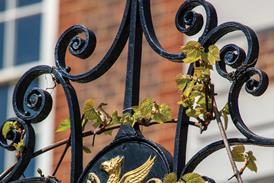Journalists, lawyers and crooks mixed freely in post-war London. James Morton recalls a golden age for the Fleet Street crime writer and the libel lawyers next door.
Fifty years ago there wasn’t a legal press as we know it. There was of course the Gazette, but that was still a monthly.
There were the Solicitors Journal and the Law Journal but it wasn’t until the 1980s that The Times and other broadsheets started weekly law columns.
That doesn’t mean to say that the public were not fascinated with what went on in the courts.
Local and national papers reported committal proceedings in detail and, since trials lasted only a few days, the nationals had more or less the whole of the evidence.
In fact, in the bad old days of capital punishment, defended divorces and seemingly even juicier libel actions than today, the public were avid readers of the behaviour of district nurses wielding instruments and scoutmasters in Hull.
I can trace my own interest in criminal law back to the time when my parents took the News Of The World, something which they hid under a rug in the car when – admittedly infrequently – they went to church.
In those days El Vinos in Fleet Street and, to a lesser extent, the Wig and Pen Club opposite the Law Courts were the haunts of journalists, who poured themselves through the doors in the afternoon, making way for the barristers in the evening. At that time if barristers entertained a solicitor it was known as ‘hugging the attorney’ and was a disciplinary offence, so solicitors rarely ventured there.
Lord Goodman’s favourite meeting spot was the Kardomah coffee shop in High Holborn.The 1950s threw up one extraordinarily talented ‘crime investigator’, as Thomas Duncan Webb liked to call himself, and one great jury advocate in those now-forgotten days when a raft of civil cases required a jury.
A definite chancer, Webb began his career with the South London Press before he went to the Daily Express and then the People. Webb was quite prepared to put himself physically at risk – the gangleader Jack Spot broke his arm – and to assume disguises to obtain his information. It is he who is said to have coined the phrase ‘I made
my excuses and left’ after being offered what were described as ‘vice services’. But possibly not always – earlier he had a bruising encounter with a prostitute when, after what she described as ‘connections’, he refused to leave her flat and was bound over at Marlborough Street for common assault. He also became far too close to Spot’s rival Billy Hill, for whom he later gave evidence.
Webb made his name with the case of John George Haigh, the so-called ‘acid bath murderer’. The week after Haigh’s execution Webb, casting himself as best man, arranged a remarriage of Haigh’s wife for the benefit of readers. He also followed up the story with that of the murder in October 1949 of receiver Stanley Setty by Donald Hume, who dumped bits of Setty from a plane over the Essex marshes.
In January 1950 Webb faced a contempt of court charge over his conduct in that trial. He had traced Hume’s wife and sent her a telegram, which could have been interpreted as trying to persuade her not to give evidence. The contempt was dismissed and, after Hume’s conviction and subsequent divorce, Webb married Hume’s ex-wife.
But Webb is best remembered for his successful investigation into the Messina brothers, who controlled vice in London’s West End for over two decades. In September 1950 he published his exposé of the brothers under the banner headline ‘Arrest These Four Men’. After their convictions Webb, at times a devout Roman Catholic, put an advertisement in The Times offering his thanks to St Jude. He died in September 1958.
Then, as now, beneficiaries of perceived newspaper misdemeanours were the libel lawyers, none more so than George Carman’s spiritual father Gilbert Beyfus, known as ‘The Old Fox’. He and Carman had a number of things in common – the ability to mesmerise juries, difficulty in communicating with people out of court and a somewhat messy love life. Beyfus was once the target of blackmail when he woke up one morning in the wrong bed, and he embarked upon numerous colourful marriages. In those stuffier days, it was not surprising that his hoped-for appointment to the High Court bench never materialised.
Beyfus specialised in divorce, libel and breach of promise, and the list of his high-profile successes is amazing: Liberace in an action against the Daily Mirror; Lord Goodman’s client Aneurin Bevan in his action against the Spectator, which suggested he had been drunk in Venice; the financier Sir Strati Ralli’s defence of an action brought by his former mistress; Eve Fleming, mother of Ian, when sued for enticement by Bapsy Pavri, the eccentric Marchioness of Winchester; and, in his final case, Yvonne Macpherson, who claimed she had been libelled by Margaret, Duchess of Argyll who sent a telegram saying she had been conspiring with the Duke. Mrs Macpherson received £4,500.
Rarely did Beyfus appear in criminal cases, but one of his successes was for Harry Beach, the solicitor who, when identification was in issue, advised his client to wear a wig in the dock. Beyfus first argued that it was no different from advising a client in a breach of promise case to wear dove grey so she could present a picture of demure innocence. When that did not succeed, he persuaded the Court of Appeal that the jury’s verdict was inconsistent and finally successfully argued autrefois acquit on the re-trial. He died of cancer in 1960.
When, on his retirement, Beyfus was asked the attributes of an advocate, he offered seven: lucidity of mind and expression, industry, personality, wit and humour, memory, insight into character, and, above all, the quality of judgement. Nearly 50 years later, not many would disagree.
James Morton is a former criminal Law specialist solicitor and now a freelance journalist



























No comments yet